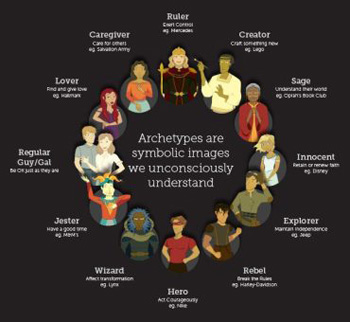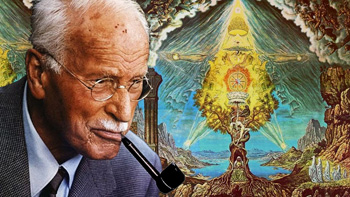Personalities
 |
 |
 |
 |
 |
 |
 |
Jung’s Archetype Theory
Swiss psychologist Carl Jung was the first non-Jewish physician among Freud’s followers. At the beginning of the relationship between Freud and Jung, Freud named him president of the International Psychoanalysis Society he had founded and called him “his adopted son, his crown prince and successor.”
But that close relationship soon ended. In 1912 the break came. When tensions between the two reached a peak, Freud ousted Jung, primarily because he did not agree with Jung’s ideas on the importance of religion in human life.
 From that moment on, Jung followed his own path developing what became known as Analytical Psychology. In 1946, Jung and his disciples founded a new International
Society of Analytical Psychology based in Switzerland, which still exists today with branches in many countries.
From that moment on, Jung followed his own path developing what became known as Analytical Psychology. In 1946, Jung and his disciples founded a new International
Society of Analytical Psychology based in Switzerland, which still exists today with branches in many countries.
The axel of Jung’s ideas is his “Archetype Theory.” This theory is complex and is not always in agreement with traditional Catholic doctrine. This explains why Jung embarked onto heretical paths that entered into Gnosis and Alchemy.
At the end of his live he developed a obscure and tortuous gnostic thinking that reminds us of the heresies of early Christianity and the Albigensians of the Middle Ages. He became a shadowy thinker whose main interests were esoteric matters of difficult comprehension.
Later in this series, I plan to make a critique of his confused thought.
Two types of unconscious
Today, however, I will focus on Jung’s concept of Archetype and its function in the human mind.
Jung believed that man possesses two types of unconscious:
These “molds” are “filled” with personal or public events as far as it refers either to a specific man – the personal unconscious – or an ensemble of men – the collective unconscious.
Some archetypes
Jung and his followers described some of the more common Archetypes known by all and present in man’s day-to-day life.
There is, for example, the Archetype of the Hero, the champion, defender, rescuer found principally in tales or animated movies for children and adolescents. This archetype helps boys and male adolescents to understand the need for sacrifice and the fight to defend law and order and the common good.
 Stories of heroes such as Superman or the Spiderman help boys to form their masculinity, to fight for an ideal and to treasure law and family.
Stories of heroes such as Superman or the Spiderman help boys to form their masculinity, to fight for an ideal and to treasure law and family.
In his book The Ego and the Id, Freud asserted that “the first link to develop the ego is the body itself, either male or female.”
This is an objective reality, since in fact boys and girls develop their self-identities based on their biological make-up. In passing let me note that the “sexual diversity” and “gender ideology” we hear about everywhere today deny the objectivity of the male and female biology for the development of one’s identity, which frontally conflicts with human nature.
According to Jung there are other Archetypes necessary for the construction of a sound and stable human mind. Among them is the Archetype of Mother, which is nurturing and comforting, showing a woman how to be a good mother. Another is the Archetype of the Wise Man. He often appears in children’s stories pictured as an old man with a white beard gifted with knowledge and wisdom.
In opposition to atheistic Freud, who denied the importance of and need for religion, Jung saw in man’s eternal quest for the divine a “necessary structure,” a good archetype capable of ordering the human psyche.
Carl Jung began his study of religion affirming that all peoples – everywhere and always – look for an image of God. All societies throughout history, according to him, have performed religious rites, be they rites of death and burial, rites of seeking and union with God, rites asking for good crops, or rites of thanksgiving for goods and favors received.
 Obviously, those pagan rites were idolatrous and unacceptable for Catholics. Many included, for example, brutal and inhuman sacrifices condemned by civilized nations. Nonetheless, what Jung wanted to stress was not the existence of one true God and one true Religion, but merely the psychological advantages that any religion gives to the human psyche, when compared to Atheism.
Obviously, those pagan rites were idolatrous and unacceptable for Catholics. Many included, for example, brutal and inhuman sacrifices condemned by civilized nations. Nonetheless, what Jung wanted to stress was not the existence of one true God and one true Religion, but merely the psychological advantages that any religion gives to the human psyche, when compared to Atheism.
So, his aim was quite restricted. When I present his world view here, I am far from taking his part. I am just trying to help TIA readers to situate Freud and Jung on the different parts of the skewed chess board of modern Psychology.
Jung, then, perceived that the quest for God was not “a childish illusion” as Freud called it (see his book The Future of an Illusion), but an essential necessity for the realization of man in this world.
In his long years of practice as a physician, Jung saw that the majority of the anxieties of his patients were caused by a lack of communion with God. In fact, he affirmed: “The greatest part of the traumas of my patients is due, without a doubt, to the lack of God.”
In a materialist and technological world, the lack of God and lack of spirituality create fertile ground for despair, depression and anxieties of every type, so typical in our epoch.
Continued

But that close relationship soon ended. In 1912 the break came. When tensions between the two reached a peak, Freud ousted Jung, primarily because he did not agree with Jung’s ideas on the importance of religion in human life.

An aged Jung at his working desk
The axel of Jung’s ideas is his “Archetype Theory.” This theory is complex and is not always in agreement with traditional Catholic doctrine. This explains why Jung embarked onto heretical paths that entered into Gnosis and Alchemy.
At the end of his live he developed a obscure and tortuous gnostic thinking that reminds us of the heresies of early Christianity and the Albigensians of the Middle Ages. He became a shadowy thinker whose main interests were esoteric matters of difficult comprehension.
Later in this series, I plan to make a critique of his confused thought.
Two types of unconscious
Today, however, I will focus on Jung’s concept of Archetype and its function in the human mind.
Jung believed that man possesses two types of unconscious:
- The personal unconscious formed by experiences, emotions, sentiments and thoughts not entirely conscious in an individual;
- The collective unconscious formed by the ensemble of experiences, events, traumas and emotions of a people, containing all the knowledge, customs and experience we share as a species. These historical experiences express the ways and forms in which a group sees and understands itself. These models of people, behaviors or personalities are what Jung called Archetypes.
These “molds” are “filled” with personal or public events as far as it refers either to a specific man – the personal unconscious – or an ensemble of men – the collective unconscious.
Some archetypes
Jung and his followers described some of the more common Archetypes known by all and present in man’s day-to-day life.
There is, for example, the Archetype of the Hero, the champion, defender, rescuer found principally in tales or animated movies for children and adolescents. This archetype helps boys and male adolescents to understand the need for sacrifice and the fight to defend law and order and the common good.

Twelve of Jung's archetypes
In his book The Ego and the Id, Freud asserted that “the first link to develop the ego is the body itself, either male or female.”
This is an objective reality, since in fact boys and girls develop their self-identities based on their biological make-up. In passing let me note that the “sexual diversity” and “gender ideology” we hear about everywhere today deny the objectivity of the male and female biology for the development of one’s identity, which frontally conflicts with human nature.
According to Jung there are other Archetypes necessary for the construction of a sound and stable human mind. Among them is the Archetype of Mother, which is nurturing and comforting, showing a woman how to be a good mother. Another is the Archetype of the Wise Man. He often appears in children’s stories pictured as an old man with a white beard gifted with knowledge and wisdom.
In opposition to atheistic Freud, who denied the importance of and need for religion, Jung saw in man’s eternal quest for the divine a “necessary structure,” a good archetype capable of ordering the human psyche.
Carl Jung began his study of religion affirming that all peoples – everywhere and always – look for an image of God. All societies throughout history, according to him, have performed religious rites, be they rites of death and burial, rites of seeking and union with God, rites asking for good crops, or rites of thanksgiving for goods and favors received.

Jung's theories slipped into Gnosis & Alchemy
So, his aim was quite restricted. When I present his world view here, I am far from taking his part. I am just trying to help TIA readers to situate Freud and Jung on the different parts of the skewed chess board of modern Psychology.
Jung, then, perceived that the quest for God was not “a childish illusion” as Freud called it (see his book The Future of an Illusion), but an essential necessity for the realization of man in this world.
In his long years of practice as a physician, Jung saw that the majority of the anxieties of his patients were caused by a lack of communion with God. In fact, he affirmed: “The greatest part of the traumas of my patients is due, without a doubt, to the lack of God.”
In a materialist and technological world, the lack of God and lack of spirituality create fertile ground for despair, depression and anxieties of every type, so typical in our epoch.
Continued

Posted March 9, 2020
______________________
______________________





